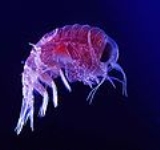
Hyperiidea
Encyclopedia
Hyperiidea is a suborder of amphipods, small aquatic crustacean
s. Unlike the other suborders of Amphipoda
, hyperiids are exclusively marine and do not occur in freshwater. Hyperiids are distinguished by their large eyes and plankton
ic habitat. Most species of hyperiids are parasites or predators of salp
s and jellyfish
in the plankton
, although Themisto gaudichaudii
and a few relatives are free-swimming predators of copepod
s and other small planktonic animals.
There is some controversy as to the number of families in the Hyperiidea, being given as between 20 and 23 depending on whether groups like the Thaumatopsidae are considered distinct or not. Here is the conservative list, of 20 families:
s of the world, including 69 species in the Southern Ocean
.
Crustacean
Crustaceans form a very large group of arthropods, usually treated as a subphylum, which includes such familiar animals as crabs, lobsters, crayfish, shrimp, krill and barnacles. The 50,000 described species range in size from Stygotantulus stocki at , to the Japanese spider crab with a leg span...
s. Unlike the other suborders of Amphipoda
Amphipoda
Amphipoda is an order of malacostracan crustaceans with no carapace and generally with laterally compressed bodies. The name amphipoda means "different-footed", and refers to the different forms of appendages, unlike isopods, where all the legs are alike. Of the 7,000 species, 5,500 are classified...
, hyperiids are exclusively marine and do not occur in freshwater. Hyperiids are distinguished by their large eyes and plankton
Plankton
Plankton are any drifting organisms that inhabit the pelagic zone of oceans, seas, or bodies of fresh water. That is, plankton are defined by their ecological niche rather than phylogenetic or taxonomic classification...
ic habitat. Most species of hyperiids are parasites or predators of salp
Salp
A salp or salpa is a barrel-shaped, planktonic tunicate. It moves by contracting, thus pumping water through its gelatinous body...
s and jellyfish
Jellyfish
Jellyfish are free-swimming members of the phylum Cnidaria. Medusa is another word for jellyfish, and refers to any free-swimming jellyfish stages in the phylum Cnidaria...
in the plankton
Plankton
Plankton are any drifting organisms that inhabit the pelagic zone of oceans, seas, or bodies of fresh water. That is, plankton are defined by their ecological niche rather than phylogenetic or taxonomic classification...
, although Themisto gaudichaudii
Themisto gaudichaudii
Themisto gaudichaudii is an amphipod crustacean of the suborder Hyperiidea.-Relatives:The 260 species of hyperiid amphipods are large-eyed and planktonic amphipods, whereas gammarid amphipods have smaller eyes and tend to live on the sea floor. The handful of species of the genus Themisto are the...
and a few relatives are free-swimming predators of copepod
Copepod
Copepods are a group of small crustaceans found in the sea and nearly every freshwater habitat. Some species are planktonic , some are benthic , and some continental species may live in limno-terrestrial habitats and other wet terrestrial places, such as swamps, under leaf fall in wet forests,...
s and other small planktonic animals.
Taxonomy
According to Vinogradov et al., there are 233 species of Hyperiidea.There is some controversy as to the number of families in the Hyperiidea, being given as between 20 and 23 depending on whether groups like the Thaumatopsidae are considered distinct or not. Here is the conservative list, of 20 families:
- Lanceolidae
- Chuneolidae
- Microphasmidae
- Archaeoscinidae
- Scinidae
- Mimonectidae
- Proscinidae
- Cystisomatidae
- Vibiliidae
- Paraphronimidae
- HyperiidaeHyperiidaeHyperiidae is a family of amphipods, containing the following genera:*Euthemisto Bovallius, 1887*Hyperia Latreille in Desmarest, 1823*Hyperiella Bovallius, 1887*Hyperoche Bovallius, 1887*Laxohyperia M. Vinogradov & Volkov, 1982...
- Dairellidae
- Phronimidae
- Phrosinidae
- Lycaeopsidae
- Anapronoidae
- Lycaeidae
- Oxycephalidae
- Platyscelidae
- Parascelidae
Distribution
Hyperiidea are known from many oceanOcean
An ocean is a major body of saline water, and a principal component of the hydrosphere. Approximately 71% of the Earth's surface is covered by ocean, a continuous body of water that is customarily divided into several principal oceans and smaller seas.More than half of this area is over 3,000...
s of the world, including 69 species in the Southern Ocean
Southern Ocean
The Southern Ocean comprises the southernmost waters of the World Ocean, generally taken to be south of 60°S latitude and encircling Antarctica. It is usually regarded as the fourth-largest of the five principal oceanic divisions...
.

